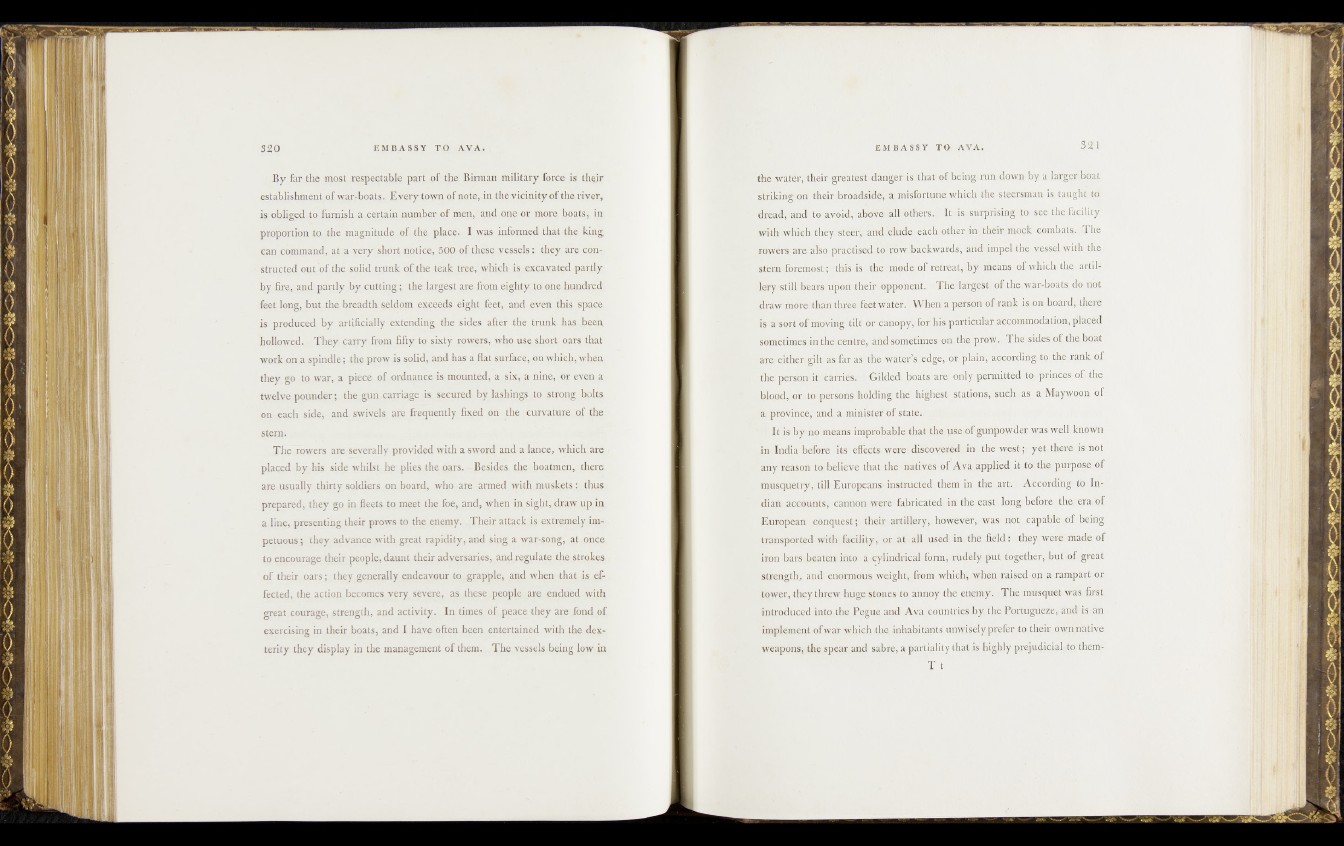
.«.By f a ^ ^ ^ g o ^ t ^g,eatatjlg paf&of;ihetI ^ ^ a ^mi]itarsyv.for6^;is Hi§&r.
estaJ^stoeg^Qfc'vsBfb^ t e . glJy.ery.tb^u pf ppfgtjj^jhe^vi^inity of the-river,
Risfu a .ccrtainm-umber. of men, afojwg^ r.inare. boats, in
proportion to the .mg.pmjfatjfe^ . fth&. place., I W94 ^onpedjth^t^tlje king
V n jrArornajnd,. ai|a very short notice, " l^7 are cWis
structed nutof,the,-splid trunk of the teak tree,".which is excavated partly
by fire,, and1 partly by cutting; the largest are^pn i.e ig l^ ^ ^n p -.k u n d red
feet long, but-the breadth seldom exceeds eight JTeet,, and even this space
is produced by artificially extending.the sides after the trunk has. been
hollowed. They carry from fifty to sixty rowers, wfo jffi*, tfra*
wotfcpn ,a apindle; tjge prow is solid, and has a fiat
they go to war, a piece of ordnance is mounted, a six, a nine, or even a
twelve pounder; the gun carriage is secured by lashings to strong bolts ,
on each side, and swivels are frequently fixed on the curvature of the
stern. _ .
The rowers are severally provided with a sword and ajance, yihK^jfarjj},
placed by his side whilst he plies the oars. Besides the boatmen, there
are usually thirty soldiers on board, who are armed with muskets : thus
prepared, they go in fleets to meet the foe, and, when in sight, draw up in
a line, presenting their prows to the enemy., Their attack is extremely impetuous
; they advance with great rapidity, and sing a war-song, ,at once
to encourage their people, daunt their adversaries, andregulate the strokes
of their oars; they generally endeavour to grapple, and when that is effected,..
the action becomes very severe, as, these people are endued with
great.courage, strength, and activity., In times of peace they are fond of
exercising in their boats, and I have often been entertained with, the dexterity
they display in the management of them. The vessels b e in g ^ p ty »
the «1 ,uei ildiPiL,jgieaifcJ^<icii'i'gi Sh4uIvft4plJbemnjti.uTi'jdow;n,l)\ a^I irger boat
1dM-iftwl i inhjfchi?meirim in lsjttgfehS ttt
<01 ol ,f ulkft olJmj^otll lers. I1 1 s usiiLipn ising to see the faci ^ 1 tH"
iwirli^wA^&Suhi\ s<i,CB|r^l^5fnde|' i i ^ I h s .
.ro.w u , Ma,.c^’ilso,pi*ie H’s^ilrUcifei^ftloitdtliiiuf^S in daw 1 pe.Udi^\<e_',i''4,i|h ifi}
I.bfic«"mod^foh i ^ t e i ^ b i h s R o h w hn h 11 i ^ u
lery still bears upon their opponent. The largest of the war-boats do not
Jhaw mine LhaiHhike «icet wfttci (l\\ Ini^i peisim.oltianj^^is^bd^pl^ijjp-
is iisort'b^oH irfg (ill)’01
3^c4c.frheti<gilWas-far 1*^*1 ulk.qf.
the per; |jn$i%ijtf
:;blood. f>3wo persons: holding the highest; jitaiiousjsuchsfasj a>j\ I a<)^i>wt
a province, and i;mini*tor obsl itc
Vl It i.sl ^ l iw VneiwR infeiSdftlhlejtliafetheause obgunp^wdermas w J l knpyti
in lndi iSliufine’iJilsr-elltcf^w'tHLJtchsi oyc^ed* uusghcvw,cst» ;yv ei>il)j.n\ispioi
ah-yueasoiintofbelieve thaUlthe'motive-.
'mus(futHi^',rti0rliur(){icJiiSviris(A,ucled’'.theiii{Jin’Jthf^4it"iij3|^i^'4yj|S1-il8S'^^us
duft, accounts, canhptrowerc lainicatcd iti ihc.cas^hijjg^aelJ^^lj^^ji#?)'!'
European .conquest then artillery, howsuvciyisvis'-uioti.c apahle.fo'hfljcfyv
tianspoited with facilhy.noj^atJia'hnuscd mrtlit^i(Jldt.^ ^ sw a oH uA ‘I y ^
iron bais*heate 11 into a oyliHllncal form »rfldyypuUkua« ther'diuilo^gri.aj:
‘Strength, andien<h:UM%S(Weight^from.yvhinh,' whin nsised..pii',a rtmpait,w.r-
tQjver, theythrew.hpg6ihtppe&.^tp^ahnpiy lhe enemy. TbuAimisrtjJtekw is 'fii ,-t
introduced into the Pcguc and Avcueojmti i|iS|bty; the,PoiLt[jgn<./c nluilj'is.hin
ixnpjqipent of war. which thebinh'<^At$I)ls" unyf.isel}#prulp^b|tljei%fn\iii}iivrii\e
weapons, the spear and sabre, a partiality tljai.is lughjj
T t